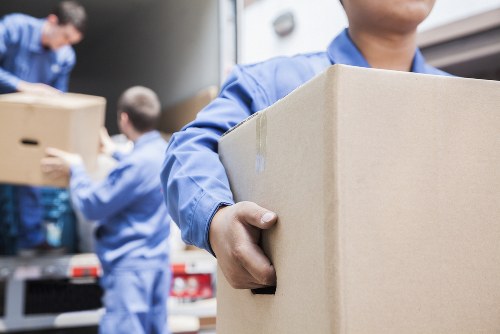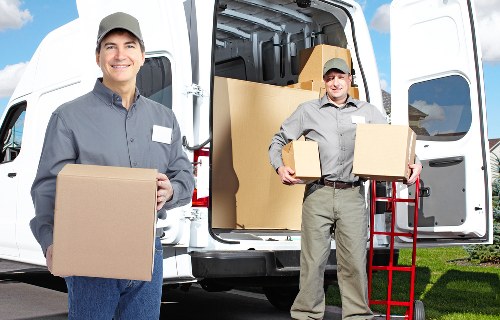Commercial Moves in Removal Van Man and Van

Planning Your Commercial Move
Embarking on a commercial move involves meticulous planning to ensure a seamless transition. Whether you’re relocating your office, retail space, or industrial facility, understanding the intricacies of the process is crucial. Proper planning can minimize downtime, reduce costs, and enhance overall efficiency.
Start by assessing your current space and determining your needs in the new location. Create a detailed inventory of all items, including furniture, equipment, and sensitive documents. This inventory will not only help in organizing but also in obtaining accurate quotes from removal companies.
Setting a realistic timeline is essential. Consider factors such as lease end dates, business operations, and employee schedules. A well-structured timeline ensures that all tasks are completed on schedule, preventing last-minute rushes and potential oversights.

Choosing the Right Removal Van
Assessing Your Needs
Selecting the appropriate removal van is a pivotal decision in your commercial move. The size and type of van should correspond to the volume and nature of your belongings. For smaller offices, a standard van may suffice, whereas larger enterprises might require multi-tonne vehicles to accommodate extensive equipment and furniture.
Evaluating Service Providers
When choosing a removal company, consider their experience in handling commercial moves. Look for providers who offer specialized services such as handling sensitive electronics, secure document transport, and customized packing solutions. Reading reviews and seeking recommendations can provide insights into the reliability and quality of their services.
Comparing Costs
Cost is a significant factor, but it shouldn’t be the sole determinant. Obtain detailed quotes from multiple providers, ensuring that all potential expenses are accounted for. Hidden fees can inflate your budget, so clarity in pricing is essential. Sometimes, paying a slightly higher rate for superior service can be more economical in the long run.

Packing Strategies for Businesses
Organizing Your Inventory
Effective packing is the backbone of a successful commercial move. Start by categorizing items based on their function and fragility. Use sturdy, standardized boxes to streamline the packing process and ensure uniformity. Label each box with its contents and the designated area in the new location to facilitate easy unpacking and setup.
Protecting Sensitive Equipment
Businesses often rely on specialized equipment that requires careful handling. Invest in high-quality packing materials such as bubble wrap, foam padding, and reinforced boxes. For electronic devices, consider using original packaging or custom crates to prevent damage during transit.
Implementing a Color-Coding System
A color-coding system can enhance organization. Assign specific colors to different departments or types of items, making it easier to identify and transport everything efficiently. This system not only saves time but also reduces the chances of misplacement or loss of essential items.

Managing the Move Day
Coordinating with Your Team
On move day, clear communication and coordination are paramount. Assign specific roles to your team members, ensuring that everyone knows their responsibilities. A well-coordinated team can expedite the packing, loading, and unloading processes, minimizing disruptions to your business operations.
Ensuring Safety and Compliance
Safety should be a top priority. Ensure that all team members are aware of safety protocols to prevent accidents and injuries. Additionally, comply with any local regulations regarding commercial transportation and moving services to avoid legal complications.
Monitoring the Move
Appoint a manager or coordinator to oversee the entire moving process. This individual will be responsible for addressing any issues that arise, ensuring that the move stays on track, and maintaining communication between the moving crew and your team.

Post-Move Setup and Support
Unpacking and Organizing
Once relocated, prioritize unpacking and setting up your new space. Start with essential items to get your business up and running quickly. Utilize your labeling system to place items in their designated areas, ensuring an organized and efficient setup.
Testing Equipment and Systems
Before fully resuming operations, test all equipment and systems to ensure they are functioning correctly. This step helps identify any damages incurred during the move and allows for timely repairs or replacements, preventing operational delays.
Evaluating the Move
After completing the move, conduct a thorough evaluation to assess what went well and identify areas for improvement. Gather feedback from your team and the removal company to refine your moving strategy for future relocations.
Benefits of Using Man and Van for Commercial Moves
Opting for a Man and Van service for your commercial move offers numerous advantages. These services are typically more flexible and personalized compared to larger moving companies. They can adapt to your specific needs, providing tailored solutions that suit your business requirements.
Moreover, Man and Van services often come with competitive pricing, making them a cost-effective choice for small to medium-sized businesses. Their local expertise ensures efficient navigation through urban areas, reducing the time and effort required for the move.
Additionally, these services tend to offer a more hands-on approach, with dedicated personnel who are invested in ensuring your move is successful. This level of attention can translate to higher satisfaction and peace of mind during a stressful relocation process.
Choosing the Right Professionals for Your Move
Experience and Expertise
Selecting a removal service with extensive experience in commercial moves is essential. Experienced professionals are adept at handling the unique challenges that come with relocating a business, such as minimizing downtime and protecting valuable assets.
Reputation and Reviews
Research the reputation of potential removal companies by reading reviews and testimonials. A company with positive feedback is likely to provide reliable and high-quality services, ensuring a smooth move. Look for indicators of customer satisfaction and responsiveness to inquiries.
Insurance and Guarantees
Ensure that the removal company offers comprehensive insurance coverage to protect your belongings during the move. Additionally, inquire about any guarantees they provide regarding the punctuality and condition of your items upon arrival at the new location.
Cost-Effective Strategies for Commercial Moves
Efficient Resource Management
Effective resource management can significantly reduce the costs associated with a commercial move. This involves optimizing the packing process, minimizing the number of trips required, and utilizing the appropriate size of removal vans to avoid unnecessary expenses.
Scheduling Flexibility
Flexibility in scheduling can lead to substantial savings. Moving during off-peak hours or seasons can result in lower rates from removal companies. Additionally, planning the move during times when your business operations are least affected can reduce the financial impact of downtime.
Reusing and Recycling Materials
Reusing packing materials and recycling wherever possible can cut down on costs. Invest in quality materials that can be repurposed for future moves or day-to-day operations, providing long-term savings and promoting sustainability.
Technology and Tools for a Smooth Move
Using Moving Software
Leveraging moving software can enhance the efficiency of your commercial move. These tools help in organizing the inventory, scheduling tasks, and tracking the progress of the move in real-time. They provide transparency and ensure that all aspects of the move are well-coordinated.
Digital Communication Platforms
Effective communication is vital during a commercial move. Utilize digital communication platforms to keep all stakeholders informed and updated. This ensures that any issues are addressed promptly and that the move proceeds smoothly.
Inventory Management Systems
An advanced inventory management system can help in tracking all items being moved. By digitally cataloging your assets, you can ensure nothing is lost or misplaced during the relocation process, providing peace of mind and organizational efficiency.
Environmental Considerations in Commercial Moves
Sustainable Packing Solutions
Incorporating sustainable packing solutions can reduce your business's environmental footprint during a move. Utilize eco-friendly materials such as recycled boxes, biodegradable packing peanuts, and reusable containers. These choices not only benefit the environment but also enhance your company's sustainability image.
Eco-Friendly Transportation
Select removal companies that prioritize eco-friendly transportation options. Vans equipped with fuel-efficient engines or alternatives like electric vehicles can significantly lower carbon emissions, contributing to a greener move.
Waste Management
Implement a waste management plan to handle packing material disposal responsibly. Partner with removal services that offer recycling or take-back programs for used materials, ensuring that waste is minimized and managed sustainably.
Maintaining Business Continuity
Minimizing Downtime
Maintaining business continuity during a move is critical. Develop a detailed plan that outlines steps to keep essential operations running smoothly. This includes setting up temporary workspaces, ensuring internet connectivity, and maintaining communication channels with clients and suppliers.
Communication with Stakeholders
Clear and consistent communication with all stakeholders is vital. Inform employees, clients, suppliers, and service providers about the move timeline, new location details, and any changes in operations. Transparent communication fosters trust and mitigates potential disruptions.
Backup Plans
Having backup plans in place can help navigate unexpected challenges during the move. Whether it's dealing with delays, equipment failures, or other unforeseen issues, proactive contingency planning ensures that your business can quickly adapt and continue operations without significant interruptions.
Legal and Compliance Aspects
Permits and Licenses
Ensure that all necessary permits and licenses are obtained for the commercial move. This includes transportation permits, zoning approvals for the new location, and any other regulatory requirements specific to your industry or region. Compliance prevents legal complications and ensures a smooth transition.
Insurance Requirements
Verify that your chosen removal company complies with insurance requirements. Adequate insurance coverage protects your business from potential losses during the move, including damages to property or loss of valuable assets.
Data Protection
Protecting sensitive business data is paramount during a move. Ensure that digital and physical data storage complies with data protection regulations. Use secure methods for transporting documents and equipment that contain confidential information to prevent data breaches and maintain compliance with legal standards.
Employee Involvement and Support
Engaging Your Team
Involving your employees in the move can enhance collaboration and morale. Assign roles and responsibilities that leverage their strengths, and encourage teamwork to facilitate a smoother relocation process. Engaged employees are more likely to contribute positively and help overcome challenges.
Providing Support and Resources
Moving can be stressful for employees, so providing support and resources is essential. Offer assistance such as moving allowances, flexible schedules, or counseling services to help them cope with the transition. Supportive measures promote a positive work environment and reduce potential disruptions to productivity.
Training and Orientation
After the move, provide training and orientation sessions to familiarize employees with the new workspace. Introduce them to new layouts, facilities, and any changes in workflows. Comprehensive orientation ensures that employees can quickly adapt and maintain their productivity levels.
Technology Integration in the New Space
Setting Up IT Infrastructure
Integrating technology effectively in your new location is crucial for maintaining business operations. Ensure that the IT infrastructure is set up properly, including internet connectivity, networking systems, and hardware installations. Efficient technology setup supports seamless business activities post-move.
Utilizing Smart Office Solutions
Consider implementing smart office solutions to enhance productivity and streamline operations. Automated lighting, climate control, and advanced security systems not only improve the working environment but also demonstrate your company's commitment to innovation and efficiency.
Cloud-Based Systems
Adopting cloud-based systems can facilitate easier access to data and applications from the new location. Cloud solutions offer flexibility, scalability, and improved collaboration, which are essential for modern businesses navigating digital transformations.
Evaluating Success and Continuous Improvement
Measuring Move Performance
After the move, assess its success by measuring key performance indicators such as adherence to the timeline, budget compliance, and the condition of moved items. Evaluating these metrics helps in understanding the effectiveness of your moving strategy and identifying areas for improvement.
Gathering Feedback
Collect feedback from all stakeholders involved in the move, including employees, clients, and the removal company. Their insights can provide valuable perspectives on what worked well and what needs adjustment, guiding future relocation efforts.
Implementing Lessons Learned
Use the lessons learned from the move to refine your strategies for future relocations. Continuous improvement ensures that each move becomes more efficient and less stressful, enhancing overall business resilience and adaptability.
Conclusion
Executing a successful commercial move requires detailed planning, the right resources, and effective management. By choosing the appropriate removal van, implementing strategic packing and moving techniques, and ensuring continuous communication and support, your business can transition smoothly to its new location.
Partnering with experienced professionals like Man and Van services can enhance the efficiency and reliability of your move, saving you time and reducing stress. Remember to evaluate your move thoroughly and apply the lessons learned for future improvements.
Contact us today to learn how our expert removal services can make your commercial move effortless and efficient. Book your service now and take the first step towards a seamless relocation experience.